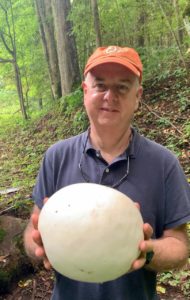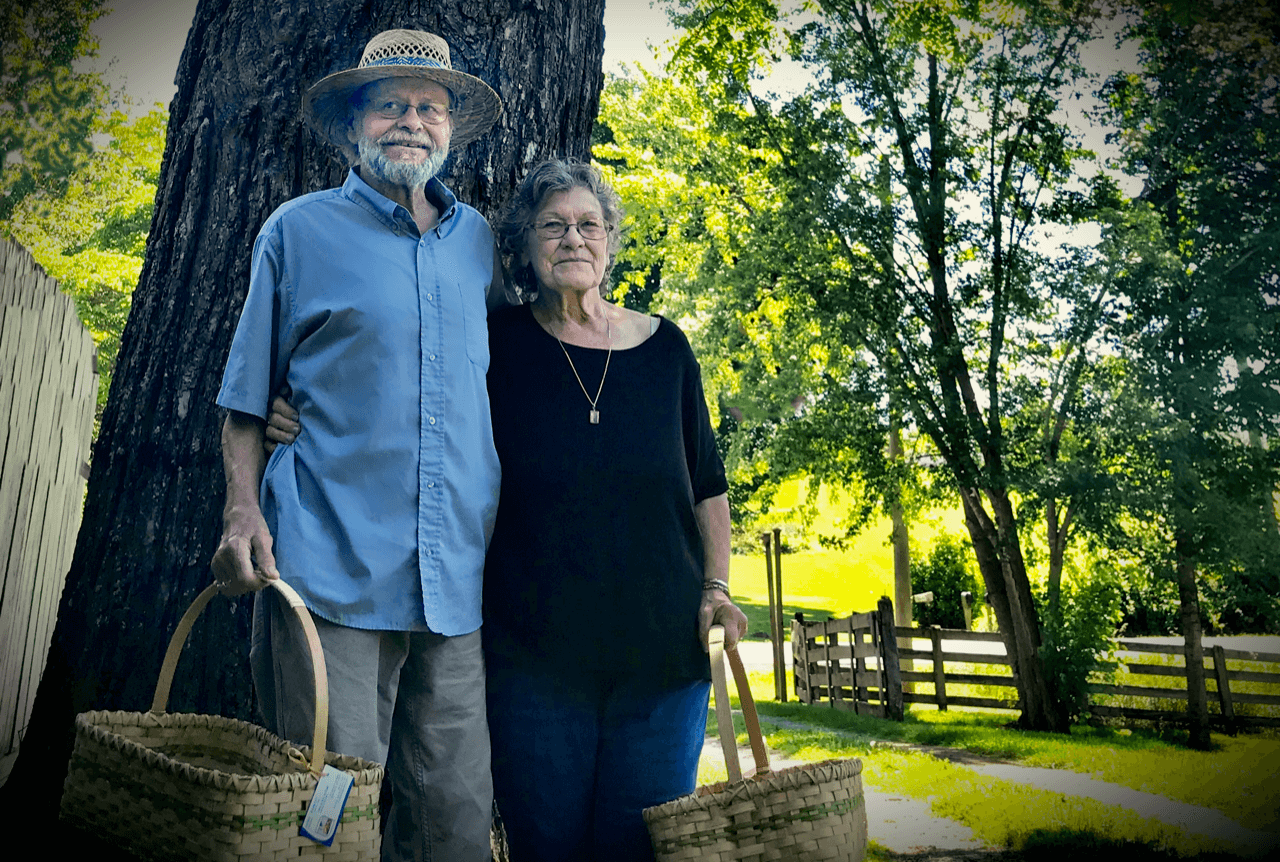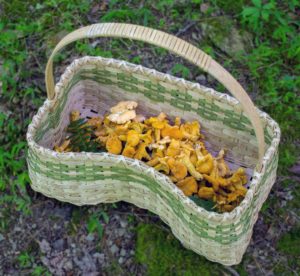
One of our many mushroom selfies.
We spend a lot of time in the New River Gorge hunting for mushrooms. When we’re not hunting mushrooms we’re usually talking about hunting mushrooms, which often prompts people to ask us why we enjoy it so much. Sometimes, we fear, they soon regret asking because we can go on and on about the many, many reasons we love it.
First and foremost, it’s an outdoor activity that keeps us moving and connected to nature. We both realized many years ago that time spent in nature is good for the mind, body, and spirit. Hunting mushrooms and taking delight in finding them, examining their uniqueness and learning their secrets helps us deepen our connection to nature.
Also, mushrooms are abundant and hunting them is a free activity that we can do throughout most of the year and during all our travels across the country. Because they vary regionally, finding new species of mushrooms becomes an exciting part of our travel experience.
And yeah, we love the taste of wild mushrooms. It’s also fun to eat what you’ve foraged. But mostly, we love mushrooms because they are so interesting. Learning about the countless varieties of these fascinating creatures (yes, creatures – keep reading!) stimulates our love of learning.

Lactarius Indigo Mushrooms
A Few Crazy Factoids About Mushrooms
- Fungi are more closely related to animals than plants. Were you taught that fungi were just a strange part of the plant kingdom? Yeah, we were too. We’ve since learned that fungi are a kingdom all its own, and its kingdom has more in common with us than with flora.
- Mushrooms are the fruiting bodies of a fungus, much like an apple is the fruiting body of a tree. The “tree” part of the fungus, called the mycelium, is hidden underground or inside decaying wood. The sole purpose of the mushroom is to deliver reproductive spores to a new, fertile place where they can grow.
- Some of the largest organisms on the planet are fungi, living and thriving down there where we can’t see. Mycelium can grow to cover thousands of acres.
- Mushrooms have different kinds of relationships with their environments. Some are parasitic and other are saprophytic, meaning they help decompose dead organic matter. But many others are mycorrhizal, meaning they have a mutually beneficial relationship with trees. In these mycorrhizal relationships, the tree performs photosynthesis and gives the mushroom sugars, and the mushroom gives the tree nutrients from the soil.

Shawn with Giant Puffball Mushroom.
West Virginia Master Naturalists Turned Mycophiles
We were introduced to the wild world of mushrooms during our years of study in the West Virginia Master Naturalist Program. We needed volunteer hours to complete our certification, and we’d heard the West Virginia Mushroom Club held a super fun annual foray, so we signed up to help at the 2017 event.
After spending the weekend listening to entertaining lectures by mushroom experts and finding hundreds of fascinating specimens during the guided walks, we were hooked. Of course, the huge foraged mushroom feast also helped build our enthusiasm.
In the two years since that foray, our love of mushroom hunting has continued to grow. So much so, that we included mushrooms in our request for commissioned art from our 2019 artist-in-residence, Rosalie Haizlett. She took what we love most about the New River Gorge and created a gorgeous painting with mushrooms front and center.

The three stages of development for an Amanita mushroom. Notice the young embryonic-like mushroom in its “egg.”
What Exactly is Mushroom Hunting?
You may ask why we call it “mushroom hunting” instead of “mushroom foraging.” This is a good question that warrants a little explanation. To refer to what we do as foraging oversimplifies the activity.
We certainly do spend a lot of time foraging choice edibles like morels, chanterelles, lion’s mane, hedgehogs (Amy’s fav), hen of the woods (Shawn’s fav) and more. But edibles represent only a tiny portion of the enormous variety of mushrooms we discover in the woods.
Some mushrooms are what we call, “edible but not incredible,” meaning it won’t harm you if you eat them but their taste or texture is not desirable. Others are toxic when eaten and some can even be deadly. Most have unknown edibility because, well, who’s going to test them?
In addition to foraging, we like to find, study and admire all mushrooms. We use seasonal and environmental indicators to search for varieties we’ve only ever seen in books. For example, we know that morels pop up in early spring after a good rain. We also know they grow in the soil (not on wood), and they have a mycorrhizal relationship with sycamores (they are mycorrhizal with many trees, but sycamores are easiest to spot in the forest). By using these clues, we were able to find our first big morel patch!
What Kind of Mushroom Is This?
When we stumble upon a mushroom we’ve never seen before (which still happens all the time) we examine its many characteristics and use the key in our favorite field guide to determine the mushroom’s name, which is way harder than it sounds. In all honesty, we can’t identify most of the mushrooms we find, but that doesn’t keep us from trying!
Does the mushroom have an egg at the base? Is it wearing a skirt? Does it have teeth, pores or gills? These are just a few of the crazy questions mushroom hunters ask. Sometimes we even run little experiments like taking a spore print or applying chemicals to see what colors develop on the cap. As you can see, when we say we are hunting for mushrooms, we are doing so much more than just foraging. We are searching, discovering and studying, too.

Judy and Mike McDade under the Black Walnut Tree that provides the natural dye for their baskets.
The Mushroom Basket Makers
Now all you really need for mushroom hunting is a small knife and something to carry the mushrooms in, but after years of walking around in the woods, we’ve learned a thing or two about comfort, convenience and proper containment. So last year we decided to invest in our hobby by designing a basket that would suit all our mushroom hunting needs.
Using our experience and the suggestions of other mycophiles, Shawn set out to design the ultimate mushroom hunting basket. After the design was created we started contacting West Virginia basket makers about bringing his idea to life.
There is no doubt that we sounded a little kooky to the first few artisans we approached, but we finally found a couple of basket makers that wove our ideas into the basket of our dreams: Judy and Mike McDade. We exchanged emails, created prototypes and finally, in June, we visited their beautiful home in Monroe County, West Virginia, where they operate their small business, Jamit Baskets.
We had a great time looking at their gorgeous basket designs and touring their property. They even let us peek in their studio and see the tools of their trade, like the custom jig Mike made to ensure he got the right shape for the base of our basket. After bidding a fond farewell to Judy and Mike, we left Monroe County with a small collection of baskets that looked even better than we’d envisioned.

Our mushroom hunting basket filled with delicious chanterelles.
A Tisket a Tasket, Our Artisan Mushroom Basket
Woven baskets have been used for collecting mushrooms for ages and are still considered best for many reasons: the open weave allows for good ventilation unlike plastic or synthetic fabric; the sturdy structure prevents the mushrooms from being crushed which is important for foraging and identification; and baskets are lightweight and quiet which ensures a peaceful walk in the woods.
Now we certainly don’t need a fancy basket like this to go mushroom hunting, but when we opened Lafayette Flats Boutique Vacation Rentals in 2014, we decided that whenever possible we would use our purchasing power to support West Virginia artists and artisans. This conscious decision to support the creative economy in West Virginia is the reason why all the art that hangs on the walls and all the books that fill our library are home-grown.
Here are all the features and benefits of the mushroom hunting basket we designed and commissioned Jamit Baskets to create.
- An indention on one side that prevents the basket from bouncing off your leg while hiking, and allows it to be held closer to the body in a thicket.
- A longitudinally oriented handle that allows the basket to be held in a natural, neutral arm and hand position.
- The strong wooden handle is wrapped to provide a more comfortable grip.
- A size that is functional for foraging without being cumbersome.
- Tall basket walls to prevent spillage.
- An open weave bottom that allows mushroom spores to disperse as you walk through the forest.
- A wide flat bottom so the basket can sit on the sloped ground without falling over.
- Black walnut dye on this all-natural basket to ensure food safety.

Shawn with a Hen of the Woods Mushroom.
How to Become a Proper Mushroom Hunter
Time spent in the woods looking for mushrooms is always the best experience, but we have a few more suggestions for those of you interested in mushroom hunting.
Find fellow mushroom hunters and maybe even a mushroom mentor.
We are fortunate to call Nancy Ward our friend and mushroom mentor. She’s an expert mycologist with many years of experience and her enthusiasm for the study of mushrooms is inspiring. Walking through the woods with Nancy is like digesting a field guide in real-time and space!
Once you start getting into mushrooms, many opportunities will present themselves for engagement with other mushroom hunters. Take them! Walking with others – even if they are only slightly more knowledgeable than you – is extremely beneficial.
Utilize all the mushroom resources.
We subscribe to Learn Your Land a YouTube series by Adam Haritan. He’s so educational and entertaining that we often travel to regional conferences to listen to him speak. He’s now offering a great online class about edible and medicinal mushrooms.
There is a large assortment of mushroom field guides available, but most are specific to a certain region. For our neck of the woods, here are the ones we recommend: “Mushrooms of West Virginia and the Central Appalachians” by William C. Roody; “The Complete Mushroom Hunter: An Illustrated Guide to Finding, Harvesting, and Enjoying Wild Mushrooms” by Gary Lincoff; and “Appalachian Mushrooms: A Field Guide” by Walter E. Sturgeon.
Get involved with your local mushroom club.
As members of the West Virginia Mushroom Club, we participate in free group walks throughout the year and attend the annual mushroom foray. It’s a great way to network with folks that share our interests.
We also find it super helpful to be members of the West Virginia Mushroom Club Facebook group. We get to see what other people are finding in real-time and learn/verify mushroom identifications.
Who are we? Amy & Shawn, New River Gorge hikers, WV Master Naturalists, and owners of Lafayette Flats Boutique Vacation Rentals.
Leave us a question or comment or join our email group to stay in touch. We often send our subscribers tips for enjoying nature and insider info about the New River Gorge.